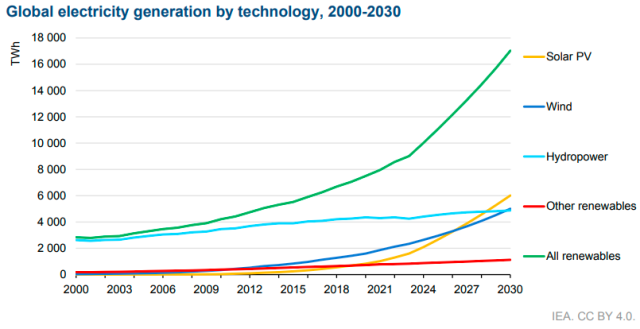International Energy Agency (IEA) has released a new forecast projecting that global renewable energy capacity will grow by 2.7 times by 2030, surpassing countries’ current renewable energy ambitions by nearly 25 percent. Despite this, the growth falls short of the goal to triple renewable capacity set by nearly 200 countries at the COP28 climate summit.
Renewables 2024 report said the world is set to add over 5,500 GW of new renewable energy capacity between 2024 and 2030. This is almost three times the growth seen between 2017 and 2023, with 670 GW expected to be added in 2024 alone.
By 2030, renewables are projected to generate nearly half of global electricity, with solar PV and wind power doubling their share to 30 percent of the global electricity mix.
The report notes that renewable energy is growing faster than governments’ existing targets. Nearly 70 countries, representing 80 percent of the world’s renewable power capacity, are on course to meet or exceed their renewable goals for 2030.
Key Insights from the Report:
Policy Impact: Climate and energy security policies in nearly 140 countries have played a crucial role in making renewables more cost-competitive than fossil fuel-based power plants. These policies are unlocking new demand from the private sector and households. Additionally, industrial policies that encourage local manufacturing of solar panels and wind turbines are fostering the growth of domestic markets.
Global Growth: The IEA forecasts that 5,500 gigawatts (GW) of new renewable capacity will become operational by 2030. Annual capacity additions are expected to reach nearly 940 GW by 2030, which is 70 percent higher than the record levels achieved in 2023. Solar PV and wind are expected to account for 95 percent of this growth due to their increasing economic attractiveness.
China and Solar PV Lead the Way
China is set to dominate global renewable energy expansion, accounting for 60 percent of the growth in global capacity by 2030. The country is forecast to be home to almost half of all renewable energy capacity installed worldwide by then. China is expected to surpass its 2030 target of 1,200 GW of solar PV and wind capacity by six years. The country’s rapid growth has been fueled by the end of feed-in tariffs in 2020, which led to a quadrupling of solar PV capacity and a doubling of wind capacity.
Europe, the US, and India
European Union and United States: Both regions are expected to double their pace of renewable capacity growth between 2024 and 2030. In the U.S., the Inflation Reduction Act’s tax credits will drive growth, while competitive auctions and corporate power purchase agreements will expand the EU’s renewable capacity. The EU is on track to meet its 600 GW solar PV target by 2030, but more effort is needed for wind energy.
India: India is forecast to experience the fastest renewable energy growth among major economies. Increased auctions, new support schemes for rooftop solar PV, and stronger financial performance of utility companies are driving rapid expansion.
Technology Breakdown
Solar Power: Solar PV is projected to account for 80 percent of the global renewable capacity growth between now and 2030. The adoption of solar PV is accelerating due to declining costs, faster permitting timelines, and strong social acceptance. This growth will be driven by both large-scale solar projects and distributed applications among households and businesses.
Wind Energy: Global wind capacity is expected to double its expansion rate between 2024 and 2030, compared to the period between 2017 and 2023. However, the growth in hydropower will remain stable, largely driven by China, India, ASEAN, and Africa.
Other Renewables: Technologies like bioenergy, geothermal, concentrated solar power, and ocean energy are expected to decline due to limited policy support.
Hydrogen’s Role in the Future of Renewables
Despite increased policy support, hydrogen from renewable energy sources is projected to account for only 4 percent of total hydrogen production by 2030. While global electrolyser capacity is expected to increase fifty-fold by the end of the decade, only part of this capacity will be powered by new renewable energy plants. Hydrogen is expected to drive only 43 GW of new renewable capacity by 2030, accounting for less than 1 percent of global renewable energy expansion.
Conclusion
The IEA’s forecast underscores the tremendous strides being made in renewable energy, with policies and market conditions driving strong growth. However, to meet the COP28 goal of tripling global renewable capacity by 2030, governments must take more aggressive action in the coming years. The IEA suggests that this target is still within reach if the right policies are adopted soon.

